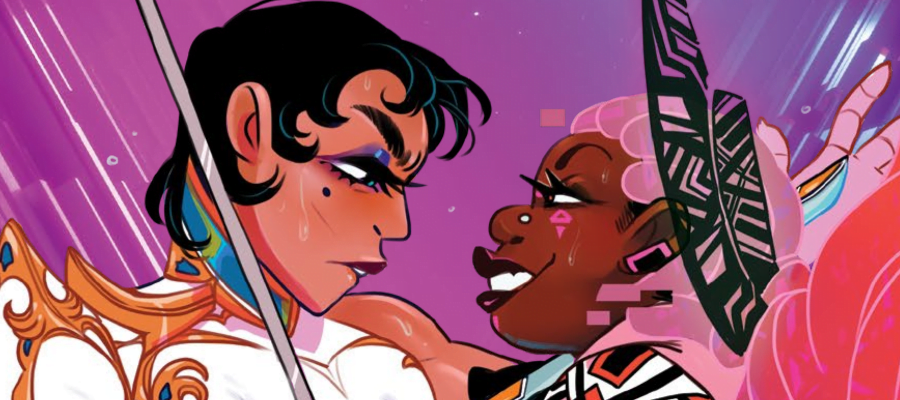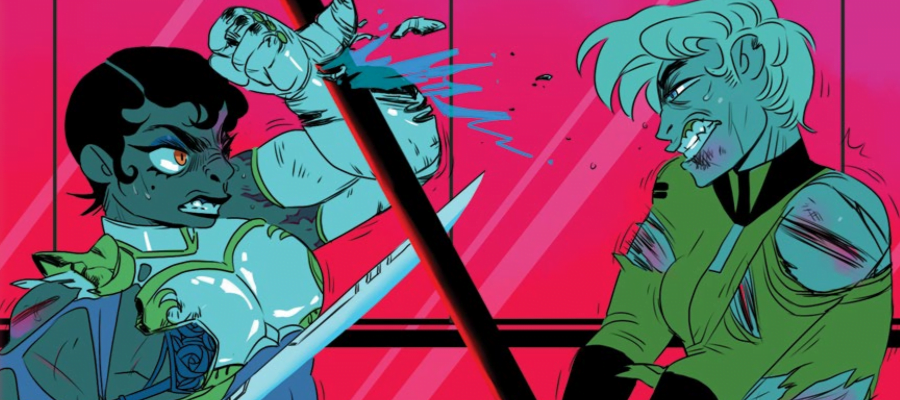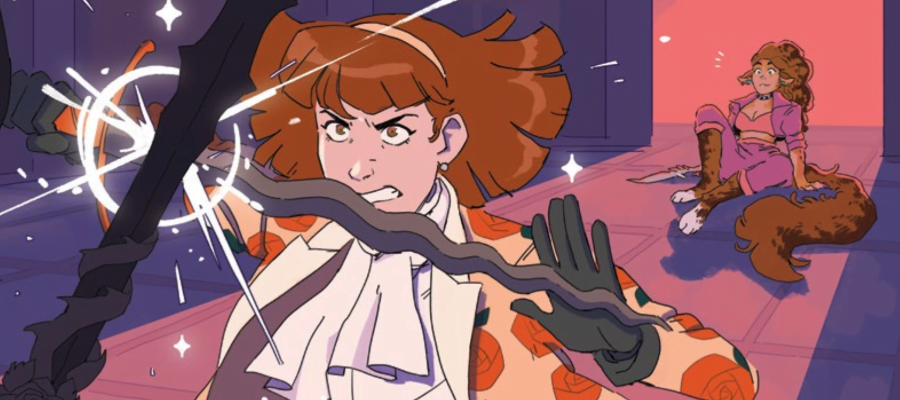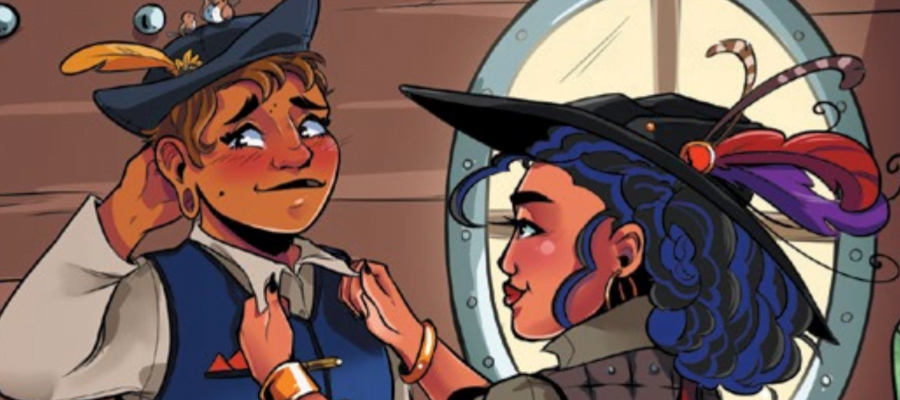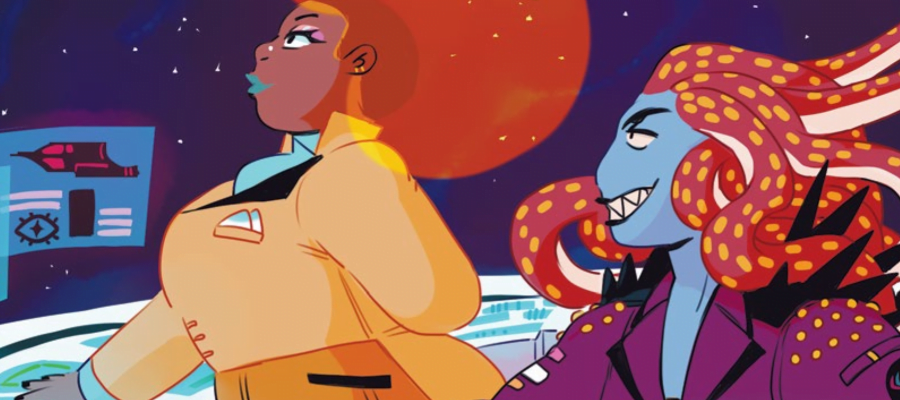I feel ill equipped to even examine this book.
I do not think I am considered aesthetically or in my presentation particularly thirsty, I own no swords nor do I feel that that’s a deeply spiritual failing on my part, and I am not in any but the most technically accepting and deliberately broad definition an lesbians. I’m not asking for anyone to change the qualifications on my part.
“Ah,” you may glibly say, “Talen, that doesn’t mean you have to be those things to participate in this game,” okay, cool, great, thank you for explaining the basics of fiction to me. I can understand that that’s something you may feel you have to do with my demonstration of difficulty grappling with that.
Come along, and maybe you’ll learn more about me by listening to me, as I talk about this book, and the game it ostensibly is about.
Thirsty Sword Lesbians is a Powered By The Apocalypse engine game. Not a Forged in the Dark engine game, of which you’ve probably heard me talk about to the extent that you’re frustrated with me; I’ve talked about Blades in the Dark, Brinkwood: Blood of Tyrants, Scum & Villainy and Girl By Moonlight, a set of games I own and happily extol, and I feel I’m only a moment from getting a game started in any of them when I can get my players together. Instead, this is the system that I am led to understand gave rise to that whole lovely ecology of Dice Pools and Stresses and Harms and Devil’s Bargains.
Now I need you to understand, I have not played this game. I haven’t played any of the Powered by the Apocalypse games I own either. I haven’t played Monster of the Week or Avatar: The Last Airbender either. All I know about them I have learned from reading the books, and unfortunately, that’s kind of part of the problem. Through reading these books I have not got a clear idea of how this game plays. What players are doing, what are they invested in, how do they think of the world in front of them?
The engine of the game is built around players taking actions, referred to as ‘moves’ that are drawn from a specific, character-centric set of moves, or generally large pool of moves that are known as ‘basic’ moves. Everything, as I understand it, is a move; when you fight, it’s a move, but also when you fail at something, your GM gets to make a move that represents that. The entire mechanical system can be framed in this way, with a set of moves that trigger moves, and conditions that are the results of moves. It’s elegant, undeniably! I mean it’s elegant in conception.
In practice it is overwhelming.
Sorry, let me be clearer: In practice, I, a 4th edition D&D veteran, find this game’s approach overwhelming.
When I talk about approach I mean the way that the player engages with the game. Any time I pick up an RPG you’ll probably see me do the same thing – flip the book open and see how hard it is to learn about a player character. In Thirsty Sword Lesbians, the player character building kicks in at page 44 of 224, which is to say, you get about a quarter of the way through the book before you, a player, learn what you can be in this world.
What comes before that?
It’s a lot of stuff I’d normally file as priming. You have to learn the basics of what an RPG is (every RPG does after all), then there’s a player’s agenda section, five pages on safety and consent, and about twenty pages of teaching you the basics of how to make a move in this game. Which means, reading through the book in standard, the game will tell me ‘you can do these things in this world’ before I’ve ever been anchored into what that means, what the character I’ll be playing in this story is beyond a base representation of ‘a thirsty sword lesbian.’
And that’s not stated in the text, it’s just on the cover. By that stage, the game is explaining to you how to handle layers of Formidable NPC Conditions while your player character is ‘an individual Player Character.’ But don’t worry, it’s given you a bunch of bullet points about ways to flirt, wanted to get that in first. The book shows you the XP and advancement system before it tells you what kind of character you can play. You know how your character can leave the story before you can know what this character could be.
Aesthetically this book is extremely thorough and deliberately incoherent. There’s no setting it wants to extol so the art ranges from Nordic myths to space faring laser adventures. That bums me out a bit, because I think a setting is a thing that gives you control over the language and control of a game.
It’s not like it doesn’t have an aesthetic: It’s a very specific vibe from a very specific type of queerness, a very specific vibe of Brightly Coloured Deliberately Not The Normal Type Of Queer that I know sings to a lot of people. I know, I have a lot of friends in this space. The game even renames the Gamemaster to the Gaymaster and I can imagine the people who wrote that line beaming happily about it even as I imagine the editor I live with rolling her eyes so hard they fall out of her skull.
The game wants to be – well, I mean it’s in the name, it’s a thirsty game which tells you how to flirt and uses harms like ‘you are humiliated and the news will spread’ alongside things like ‘you’re rendered helpless for the scene.’ There’s a basic move for being smitten. You can kiss to get bonuses. Thirsty Sword Lesbians is a book that reads to me as unapologetically and completely comfortable in being horny and being horny for things that are largely seen as unpolite or inappropriate ways to be horny, which, you know, queer life, queer love, that’s fine, that’s not a problem, it’s a thing we need and need more of.
It’s funny that all this indulgence starts then not with ‘here is the fantasy, here is what you can inhabit, here’s what you can be’ but instead ‘eat your greens, it’s time to learn about conditions.’
I really need to play a PBTA game if I’m going to try and read more of these books. The more I read them the more I’m left helplessly wondering if this entire game system is an attempt to systematise a kind of storytelling that I don’t need systematised, since it’s just how I envision telling a story in a roleplaying game. It’s got to be more than that, it’s got to be deeper than that, I need to see some of this play experience happening and maybe even happening around me while I learn, because as it is, the game system seems like something I’d struggle to run and struggle even harder to play.
I know part of this has to be my play experience. I’ve been at lots of RPG tables, but at tables where none of the players are that comfortable with romance in the narrative and, as a GM, where they’re even reluctant, or uncomfortable examining romantic angles with characters. I know ostensibly, I’d love to have that kind of thing in a game, but the idea of sitting down at a table with the kind of players this game represents makes me feel like the first move I should be using is Leave These People To Their Own Fun.
“Everyone’s included except fascists and bigots” is a great principle, but it’s a lot harder to do. I don’t feel welcome. I feel like this is a book that has firm opinions on its vibes, a demand for how the game should feel and if you can’t get along with it, it doesn’t have advice for you to do so. It doesn’t know how. It’s not like the game is putting you under pressure to play it! It’s just like walking into someone’s dressing room and going: Oh, I do not belong here.
Could a different approach help? I think so, but then the question becomes, why should the approach be different? Who struggles to engage with it? There are people doing lets plays of Thirsty Sword Lesbians and recommendations of using it for a host of settings. Oh, obligatory mention of The Locked Tomb though good god I do not see that working at all and I’d need to see it in play. I bet it’s good at Steven Universe, or Undertale, which are also universes that I feel tell me to go away.
I guess in the end this book makes me feel old, and sad. I have never felt like I belong in queer spaces, in no small part because I don’t feel like I’m allowed to express myself, or that my expressing myself is a thing that’s ever safe to do. This is true in the cult I grew up in, the church I graduated to, the communities I moved on to and the now I live in. This game wants to extol a vision of queerness and pride, of people who have big feelings and who care about expressing them, and yet, the kinds of things I like and want to be and want to see happen in the world do not belong. I can see straight guys playing this game more readily than I can see me playing this game. This game is built around celebrating a thing that has my entire life been something I am outside.
There’s this quote, if you can’t dance to it, it’s not my revolution. I am surrounded on all sides by people who cannot help but enthuse about the queer euphoria and joy their embrace of their identities has brought them and they dance.
And I cannot dance.
